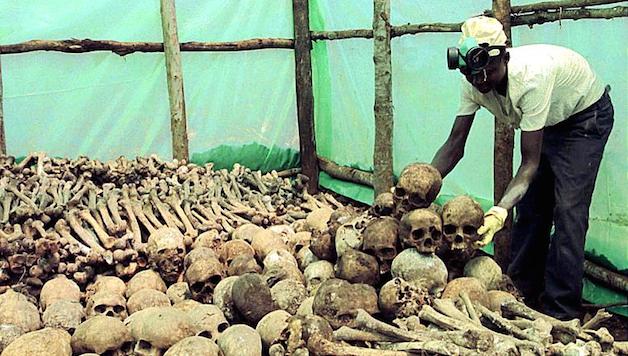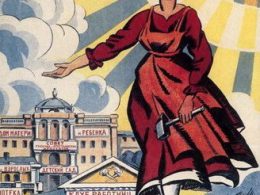By Andy Ford
Twenty years ago, nearly a million people were massacred in Rwanda. At the time, it went largely unreported. But it was a direct legacy of a century of colonial rule – the French state, under ‘socialist’ president, François Mitterrand, complicit in the genocide.
The Rwandan genocide of April-June 1994 must rank as one of the most horrifying events in history. Nine hundred thousand people are estimated to have died, often at the hands of their neighbours and workmates. Rwanda is a small country in the heart of Africa. It has fertile volcanic soil, plenty of rain and lies thousands of feet above sea level so that malaria does not affect humans and tsetse flies do not affect cattle. Therefore it has always had a high population density and was relatively remote from European influence.
Pre-colonial Rwanda was a society gradually moving into a state form, with the emergence of a ‘king’ and state from a background of clan society. It was an oral, pre-literate society. King Rwabugiri (1860-95) consolidated the first real kingdom by conquering and co-opting other clans and chiefdoms. It was a society based on cattle – the ‘ubuhake’ system, whereby farmers with cattle ‘lend’ those cattle to people in return for service and loyalty, and/or give access to land for pasture. For the less well-off there was ‘ubureetwa’ – the grant of the use of land in return for unpaid labour – and ‘akaze’, which was just unpaid labour.
‘Tutsi’ was a loose term for those with cattle, ‘Hutu’ for those without. But movement and inter-marriage between the groups was quite common, and they spoke the same language. A Belgian missionary observed in 1922: “The term Tutsi and Hutu refers not to descent, but to social condition or wealth, especially as regards cattle. Whoever is a chief or who is rich, will be referred to as Tutsi”. (Catherine Newbury, The Cohesion of Oppression: Clientship and Ethnicity in Rwanda 1860-1960, Columbia University Press, 1993)
Colonial Rwanda
Rwanda had been allocated to Germany in 1884 at the Congress of Berlin which carved up the continent between the European powers in their ‘scramble for Africa’. Nevertheless, the German ruling class only got hold of its new possession in 1894, when Count von Gatzen reached the royal court at Kigali. Germany, however, had little impact on the remote colony, although it did chase out Belgian incursions from Congo – under the control of king Leopold II of Belgium – and extract tribute in the form of a hut tax through the Rwandan king.
Hut or poll taxes had been used by the British empire in South Africa to force self-sufficient peasant farmers into the capitalist economy, working for wages for British companies in order to be able to pay the taxes imposed on them.
In 1917 Belgian forces invaded from Congo and took control. They worked through the indigenous rulers, favouring some chiefs with weapons and support, in return for help in extracting taxes and raw materials. The pre-existing exploitation of the peasants (Hutu) was intensified by the Belgians, through the chiefs (Tutsi). Newbury writes: “Chiefs who co-operated with the Belgians saw their power and wealth enhanced; in return they were expected to impose heavy burdens on their people, to supply porters and food to Europeans in the early period, to carry out forced cultivation and road building later”.
A clear example is the ‘war’ against the Bukunzi kingdom 1923-25. The Tutsi chiefs wanted the cattle of the ruler of Bukunzi, while Belgium wanted to tax them. Bukunzi lay even higher in the mountains than the rest of Rwanda and had defeated German expeditions in 1907, 1909 and 1914. A succession crisis provided the opportunity. The first Belgian force lost its way, but a second subjected the area to a brutal military occupation, assisted by indigenous Rwandan forces who received the cattle in return. The queen of Bukunzi died in battle with the Belgian forces in 1925.
The chiefs took produce or enforced labour, often claiming them as traditional forms of service in order to satisfy not only the colonial rulers but also their own needs, enforced by evictions and violence. Newbury quotes a Rwandan peasant speaking in 1970: “They would come and take your cow, on the pretext that you were a rebel. You couldn’t say anything, for the least resistance they would put you in chains or sometimes kill”.
There was a growth in ubureetwa and ubuhake as more peasants became clients of the better-off farmers and chiefs. Without protection they were liable to lose their cattle, land or both. For instance, in 1931 the Belgian rulers decided to increase coffee production. They dictated that each Tutsi chief had to organise the cultivation of 1,000 coffee plants, demanding that those in the ubereetwa (land use) system grow 54 plants each, as unpaid labour.
Although the Belgians incorporated Rwandan customs like ubuhake and ubureetwa into colonial law, a Hutu peasant in dispute would find himself appealing to Tutsi chiefs in the indigenous court system. The colonial rulers had perverted and intensified the traditional obligations to exploit their colony. They had commodified pre-capitalist forms of labour.
Super-exploitation
In the 1920s and 1930s the Belgian administration of Rwanda became more systematic. In 1921 the colonial rulers decreed that those who owned more than ten cattle had to pay a tax of ten francs per cow; those with fewer than ten paid five francs. This created a division between those with cattle and those with few or none. Then they set up the notorious 1933 census which compelled everyone to be identified as ‘Tutsi’ (15%), ‘Hutu’ (80%) or ‘Twa’ (5%), the Twa being the original hunter-gather population of the country.
During the second world war, the market for Rwandan goods boomed and many roads were built on the akaze system of enforced unpaid labour, which became especially hated. The aim was to use the fertile soils and plentiful people and cattle of Rwanda to feed industrial and mining centres in the Congo.
Their exploitation, through the Tutsi chiefs, intensified with forced cultivation of cash crops (hypocritically said to be for ‘educational purposes’), the drainage of marshes for coffee, conscription for work in the mines of Congo, or forced settlement of cleared forest lands. The peasants were ruthlessly squeezed, so much so that 300,000 died in a ‘famine’ in 1943, at the same time as food was being exported. The forced labour system, however, could not be sustained in the face of growing mass opposition. Ubureetwa was abolished in law in 1949, ubuhake in 1954, although it continued in many areas.
Nonetheless, the divide-and-rule policy of educating only Tutsis and using them to administer the state and staff commercial posts kept power in the hands of the Tutsi minority. It also allowed a very small number of Belgians to dominate four or five million Rwandans. It was classic colonialism as first developed by the British ruling class in Ireland, Sri Lanka, India and around the world. Karl Marx pointed out that Britain ruled India with an Indian army maintained at Indian expense. The same model was applied to Rwanda by the Belgian ruling class.
Even the Belgian governor of Congo, Charles Voisin, admitted in 1930 that, “Without the collaboration of indigenous authorities the occupying power would find itself powerless and faced with anarchy”. (Quoted in Newbury) In the case of Rwanda, the ‘ethnic divide’ was largely created by the colonisers in the first place.
Hutu uprising
As time went on a Hutu consciousness emerged among the rural masses, led by Hutu traders and lower level Hutu clerical workers in the towns who were excluded from higher posts in the colonial administration. Two of the main leaders were journalists on Catholic papers, who could only get a hearing by harnessing the simmering rural anger.
They began to agitate against the royal court and Tutsi domination in ethnic terms, calling for the abolition of forced labour, and for paid work with contracts, rural credit and the admission of Hutus to schools and colleges. These important demands were limited, however, by the tendency to frame them around Hutu identity. In the absence of a programme for the socialist transformation of society, the demands amounted to taking from the Tutsi to give to the Hutu. The Hutu leaders themselves depended on the division of Rwandan society, and even opposed ‘de-tribalising’ identity cards on the grounds that they wanted to measure progress towards equality.
The Belgian rulers tried in vain to maintain their system by experimenting with ‘ethnic’ representation in the emerging institutions, but the situation in the rural areas remained practically the same. Only 6% of the advisory state council were Hutu, despite them constituting 80% of the population. Hutu leaders mobilised around a call for ‘majority rule’, although the Hutu movement itself began to polarise between those who emphasised an anti-Tutsi stance and those calling for equality for all groups.
In November 1959 there was a mass uprising of Hutu, following the beating of a Hutu chief by Tutsi youths. Hut burning and violence spread across the country, with brutal suppression attempted by better organised and armed Tutsi forces. The Belgians were left suspended in mid-air without their native collaborators. They could only re-establish a semblance of order by appointing Hutu chiefs, abandoning their erstwhile Tutsi supporters to their fate. At elections in 1960 Hutu parties won 84% of the vote. Independence followed in July 1962.
France intervenes
With the legacy of division and exploitation, and continued meddling by Belgium, now trying to rule through the Hutu elite, the government in Rwanda was never stable up to the seizure of power in 1973 by Juvénal Habyarimana. His coup was backed by France seeking ‘stability’ through a one-party state. In some ways the coup was proof that Belgium had no hope of maintaining a neo-colonial domination of Rwanda, which passed into a French sphere of influence.
It was a one-party, anti-communist dictatorship, and a stooge of the French state. Habyarimana regularly got over 99% of the vote at rigged elections but gradually alienated his support so that even Hutu leaders deserted him or fled abroad. His main source of support was the Akazu group, mainly drawn from his home region.
They relied more and more on Hutu extremism to make up for their lack of progress on economic and social matters. More than 90% of the population remained as subsistence farmers and less than 5% had access to electricity. In 1989 the price of coffee collapsed and Habayarima accepted an IMF adjustment programme – severe austerity – which impoverished many in Rwanda.
Utilising these grievances, the Rwandan Patriotic Front (RPF), entered Rwanda from Uganda in 1990. The RPF was a mainly Tutsi guerrilla army, led by Rwanda’s present authoritarian president, Paul Kagame. It was only prevented from overthrowing the regime by French intervention in February 1993.
Habyarimana’s regime was losing support – Hutu supremacism could not feed people or give them clean drinking water or electricity. Habyarimana was forced to look for an agreement with the RPF, signing the Arusha accords in 1993, with France and the US trying to impose a power-sharing government.
In April 1994, however, Habyarimana’s plane was shot down, probably by the Akazu. With French complicity they had amassed weapons (including 500,000 machetes), lists of Tutsi and a militia, the Interahamwe. Over the three months that followed nearly a million people were killed, mostly hacked to death with machetes. The French state had been aware of the plan but tolerated it to keep its clients in power. France’s so-called ‘peacekeeping mission’ ignored the massacres and even gave safe haven to the killers. When the Interahamwe were defeated by the RPF, French forces shielded them as they fled into Zaire.
Imperialism stands condemned
In an attempt to minimise their responsibility for the horrific mass killings, the French state talks about ‘ancient hatreds’, or even claims that ‘this is how Africans are’. The far-right (and some tabloid press) say it is an example of African savagery. A slightly more sophisticated version is that unscrupulous politicians gain and keep power by using tribalism and ethnic identity. This is the theme of a report by Human Rights Watch, None Left to Tell the Story. The blame is still attached to the Africans. Such explanations do not really stack up.
Jared Diamond, in his book Collapse, shows the holes in the ‘ethnic hatred’ narrative. He points out that on Ijwi island in Lake Kivu, which is ethnically Rwandan but part of Congo – and so was not subject to the same ethnic identity manipulation by Belgian imperialism – the identities of Tutsi and Hutu are fluid and quite unimportant. In addition, all over Rwanda, the Twa people who are neither Tutsi not Hutu, were also attacked. In a region of northern-western Rwanda where there were few Tutsi, Hutu were murdered in large numbers.
Diamond gives a vivid portrait of life in Rwanda just before the genocide. He paints a picture of high and increasing population density leading to over-cultivation, soil erosion, and the subdivision of land holdings far below what is viable, leading to widespread malnutrition. In the villages there was a polarisation of land holdings between a ruthless, richer, landowner-peasant layer and the landless poor.
Land disputes, especially between neighbours, fathers and sons, widows and brothers-in-law, soared with ever-increasing referrals to traditional courts. Immediately before the genocide there was a huge rise in legal disputes. The whole society was raised to an unbearable tension, which broke out with terrifying savagery in the genocide. (Collapse: How Societies Choose to Fail or Survive, Penguin, 2011)
Above all, however, it is imperialism and capitalism which stand condemned at every turn. Belgian imperialism in effect created Tutsi and Hutu identities so it could loot the country. Belgian companies and colonial administrators twisted and intensified traditional Rwandan forms of labour in the interests of their profits. Even after independence, Rwanda was tied down by foreign domination, first Belgian, then French – neo-colonialism.
Only a government of the workers and poor, on the basis of a democratic socialist plan of production, could have freed the people of Rwanda from their colonial masters – and overcome the divisions they had created. It would also have needed a clear international perspective: for the socialist transformation throughout the region, in sub-Saharan Africa and further afield.
Instead, the French-backed dictatorship gradually lost support and came to rely more and more on Hutu supremacism. As the country stagnated, tensions in the countryside mounted. The French state supported the genocidal forces in order to maintain its client state in Rwanda. Its protection of the Interahamwe meant that hundreds of thousands of people were massacred.












